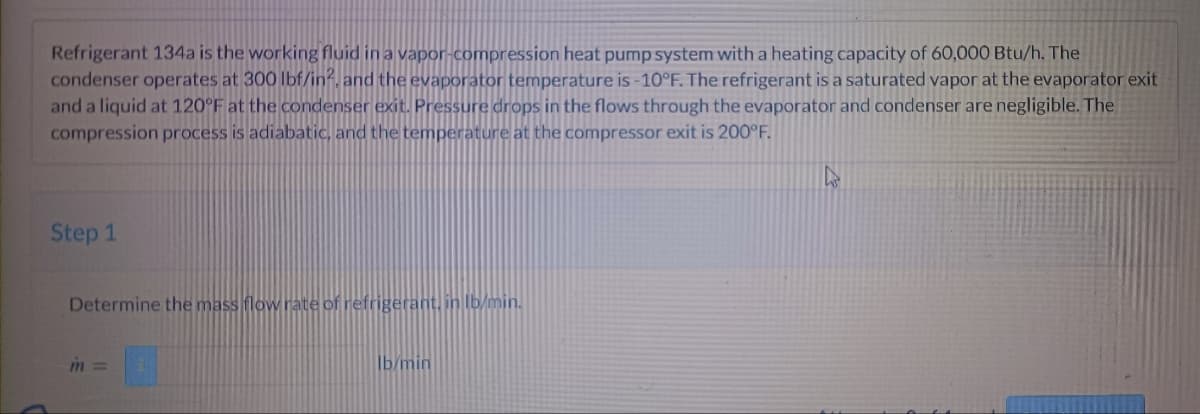Refrigerant 134a is the working fluid in a vapor-compression heat pump system with a heating capacity of 60,000 Btu/h. The condenser operates at 300 lbf/in², and the evaporator temperature is -10°F. The refrigerant is a saturated vapor at the evaporator exit and a liquid at 120°F at the condenser exit. Pressure drops in the flows through the evaporator and condenser are negligible. The compression process is adiabatic, and the temperature at the compressor exit is 200°F. 4
Refrigerant 134a is the working fluid in a vapor-compression heat pump system with a heating capacity of 60,000 Btu/h. The condenser operates at 300 lbf/in², and the evaporator temperature is -10°F. The refrigerant is a saturated vapor at the evaporator exit and a liquid at 120°F at the condenser exit. Pressure drops in the flows through the evaporator and condenser are negligible. The compression process is adiabatic, and the temperature at the compressor exit is 200°F. 4
Refrigeration and Air Conditioning Technology (MindTap Course List)
8th Edition
ISBN:9781305578296
Author:John Tomczyk, Eugene Silberstein, Bill Whitman, Bill Johnson
Publisher:John Tomczyk, Eugene Silberstein, Bill Whitman, Bill Johnson
Chapter3: Refrigeration And Refrigerants
Section: Chapter Questions
Problem 12RQ: The condensing pressure is 260 psig and the condenser outlet temperature is 108F for R-22. By how...
Related questions
Question

Transcribed Image Text:Refrigerant 134a is the working fluid in a vapor-compression heat pump system with a heating capacity of 60,000 Btu/h. The
condenser operates at 300 lbf/in², and the evaporator temperature is -10°F. The refrigerant is a saturated vapor at the evaporator exit
and a liquid at 120°F at the condenser exit. Pressure drops in the flows through the evaporator and condenser are negligible. The
compression process is adiabatic, and the temperature at the compressor exit is 200°F.
Step 1
Determine the mass flow rate of refrigerant, in lb/min.
m =
lb/min
Expert Solution
This question has been solved!
Explore an expertly crafted, step-by-step solution for a thorough understanding of key concepts.
This is a popular solution!
Trending now
This is a popular solution!
Step by step
Solved in 2 steps

Knowledge Booster
Learn more about
Need a deep-dive on the concept behind this application? Look no further. Learn more about this topic, mechanical-engineering and related others by exploring similar questions and additional content below.Recommended textbooks for you

Refrigeration and Air Conditioning Technology (Mi…
Mechanical Engineering
ISBN:
9781305578296
Author:
John Tomczyk, Eugene Silberstein, Bill Whitman, Bill Johnson
Publisher:
Cengage Learning

Refrigeration and Air Conditioning Technology (Mi…
Mechanical Engineering
ISBN:
9781305578296
Author:
John Tomczyk, Eugene Silberstein, Bill Whitman, Bill Johnson
Publisher:
Cengage Learning